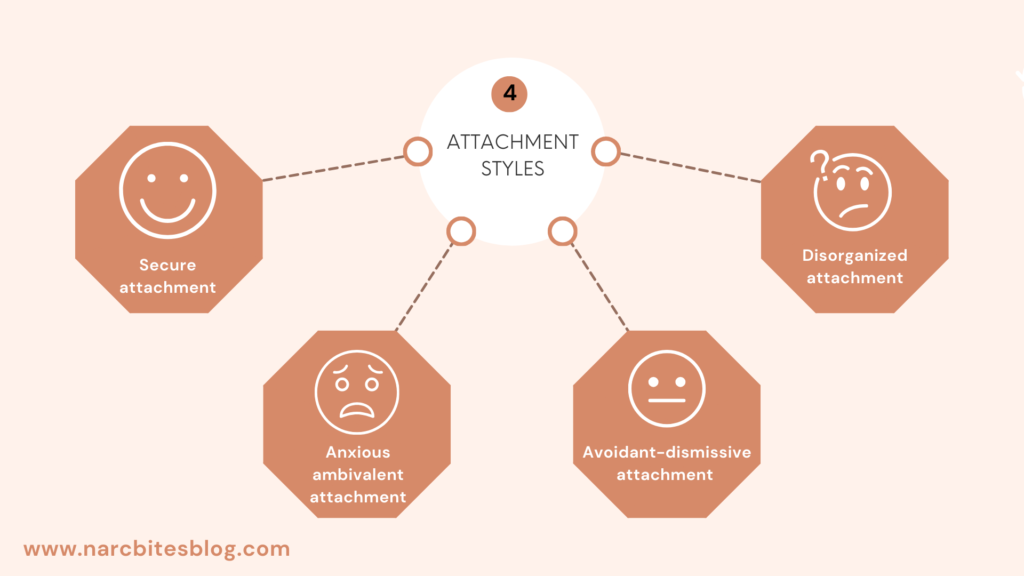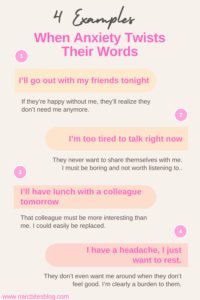A narcissist often chooses a partner with an anxious ambivalent attachment style because that person will do anything not to be abandoned. This creates a relationship dynamic that meets the narcissist’s need for control, validation, and emotional dominance while keeping the partner in a state of emotional pursuit.
Understanding why this pattern forms requires a clear view of how attachment styles operate in adult relationships and how they interact with narcissistic behavior patterns.
What Are Attachment Styles?
Attachment theory, developed by John Bowlby and later expanded by Mary Ainsworth and others, describes how early childhood relationships with caregivers shape our expectations and behaviors in adult relationships.
There are four main adult attachment styles:
- Secure attachment – These individuals are comfortable with closeness and autonomy. They trust others and handle conflict in constructive ways. They generally had responsive and consistent caregiving in childhood.
- Anxious ambivalent attachment – Also known as preoccupied attachment. These individuals crave closeness but fear abandonment. They tend to become overly dependent on their partners and worry that their love will not be returned. Their caregivers were often inconsistent or emotionally unpredictable.
- Avoidant-dismissive attachment – These individuals value independence and tend to withdraw when things become emotionally intense. They may struggle with vulnerability and emotional expression. Their caregivers were often emotionally unavailable or rejecting.
- Disorganized attachment – A combination of anxious and avoidant traits, often seen in individuals who have experienced trauma or abuse. Their relationships can be chaotic and marked by fear and confusion.
The narcissist typically aligns with avoidant or disorganized attachment, while the partner they often choose falls into the anxious ambivalent category.
Traits of a Partner with an Anxious Ambivalent Attachment Style
Someone with an anxious ambivalent attachment style constantly worries that others may not truly love them. They are often jealous and fear being left or replaced. They long to be extremely close to others, to the point of emotional fusion. They may expect the other person to know what they feel without words and to fulfill needs they themselves can barely articulate.
Their relationships are marked by emotional extremes. Their desire for intimacy and reassurance is intense, and when it feels unmet, they may become demanding or emotionally volatile. This behavior often serves as a way to test whether the other person still cares or is planning to leave.
These partners can quickly alternate between clinging behavior and emotional withdrawal. After an argument, they may cry and plead for closeness, then switch to detachment or silence. They may try to rationalize the situation and approach it logically, but unresolved emotional fears quickly resurface. At the core of their reaction is a single unresolved question: “Do you still love me?”
Why a Narcissist Is Drawn to the Anxious Ambivalent Attachment Style
To the narcissist, the anxious-ambivalent partner offers several psychological advantages.
- Predictable emotional reactivity
An anxious partner reacts quickly and intensely to changes in emotional distance. This gives the narcissist a consistent source of attention, drama, and reassurance of their power in the relationship. - High tolerance for inconsistency
Because they are accustomed to inconsistency, anxious ambivalent individuals are more likely to tolerate the narcissist’s hot-and-cold behavior, emotional withholding, and manipulative tactics. What others would reject, they often try to fix. - Fear of abandonment
This is the most critical factor. Narcissists tend to maintain control in relationships by alternating idealization and devaluation. When the partner is terrified of being abandoned, they are more likely to stay, apologize, and compromise their own boundaries to restore harmony. - Willingness to self-blame
Anxiously attached partners often assume that conflict is their fault. They believe they are too needy, too emotional, or too much. Narcissists often exploit this by blaming them for problems and escaping accountability.
The Cycle That Forms
The relationship often follows a familiar cycle:
- Idealization phase
At first, the narcissist may appear highly attentive and interested. The anxious partner, starved for affection and reassurance, feels deeply seen and desired. This rapid emotional closeness reinforces their hope for a secure bond. - Devaluation phase
Once the partner is emotionally invested, the narcissist begins to withdraw, criticize, or create distance. This triggers the anxious partner’s fear of abandonment. They react with more intense efforts to reconnect, including apologizing, overexplaining, or suppressing their own needs. - Intermittent reinforcement
Occasional moments of closeness or affection are mixed with unpredictability and emotional coldness. This creates a psychological pattern where the partner stays invested, hoping the “good version” of the narcissist will return. The inconsistency makes the relationship more addictive. - Conflict and rupture
Eventually, the anxious partner’s emotional reactions become too much for the narcissist, who may escalate the conflict or disengage entirely. This may include stonewalling, silent treatment, or a complete discard. - Re-engagement
If the anxious partner reaches out again or shows vulnerability, the narcissist may return temporarily, reinforcing the bond and restarting the cycle.
This pattern keeps the anxious partner focused on maintaining the connection, while the narcissist maintains control by manipulating emotional distance.
Childhood Wounds Behind the Anxious Ambivalent Attachment Style
The anxious ambivalent partner often grew up with inconsistent caregivers who were sometimes loving and sometimes emotionally unavailable. They learned that love is unstable and must be earned through effort, appeasement, or emotional overinvestment.
The narcissist, in contrast, often experienced conditional approval or emotional neglect, leading to a fragile sense of self that requires constant external validation. They may have learned to suppress vulnerability and instead seek superiority or control as a defense.
Together, their histories fit like pieces of a dysfunctional puzzle. The anxious partner wants reassurance. The narcissist wants admiration. The anxious partner tolerates neglect to maintain closeness. The narcissist withholds closeness to maintain power.
Why This Dynamic Is So Difficult to Break
These relationships can be highly emotionally charged. Despite the emotional harm, both parties often struggle to let go.
The anxious ambivalent attachment style partner may believe that if they just love the narcissist enough or meet all their needs, the relationship will stabilize. They are often drawn to the idea of healing or fixing the other person, especially if they sense vulnerability beneath the narcissist’s surface.
The narcissist, meanwhile, sees the anxious partner as someone who provides validation, emotional labor, and a steady focus of attention. Unless they find a more ideal source of supply, they often return or hover around to keep the dynamic alive.
Recognizing the Pattern
It is important to note that this dynamic is not always visible from the outside. In fact, it often appears passionate, intense, or “meant to be.” But when examined more closely, the signs include:
- One person constantly fears being left or replaced.
- The other uses emotional distance or criticism to maintain control.
- Conflicts repeat without resolution.
- One partner consistently over-functions to keep the relationship intact.
- Emotional needs are met inconsistently or used as leverage.
If these patterns are present, the issue is not with how much someone loves or tries. The issue lies in an incompatible emotional system driven by unresolved attachment wounds and narcissistic defenses.
Moving Forward
Understanding the interplay between narcissism and anxious ambivalent attachment style is not about assigning blame. It is about recognizing a dysfunctional pattern that sustains emotional harm on both sides.
For the anxious partner, healing often begins with developing a secure internal base. This includes learning to tolerate emotional distance, practicing self-validation, and challenging beliefs that love must be earned through self-sacrifice. For those with narcissistic traits, meaningful change is possible only through self-awareness and a willingness to engage in therapeutic work that addresses core shame, emotional avoidance, and the need for control.
Ultimately, secure and respectful relationships are built on mutual recognition, not emotional dependency. Awareness of attachment dynamics can help individuals break free from destructive patterns and move toward connections that are stable, respectful, and emotionally safe.


